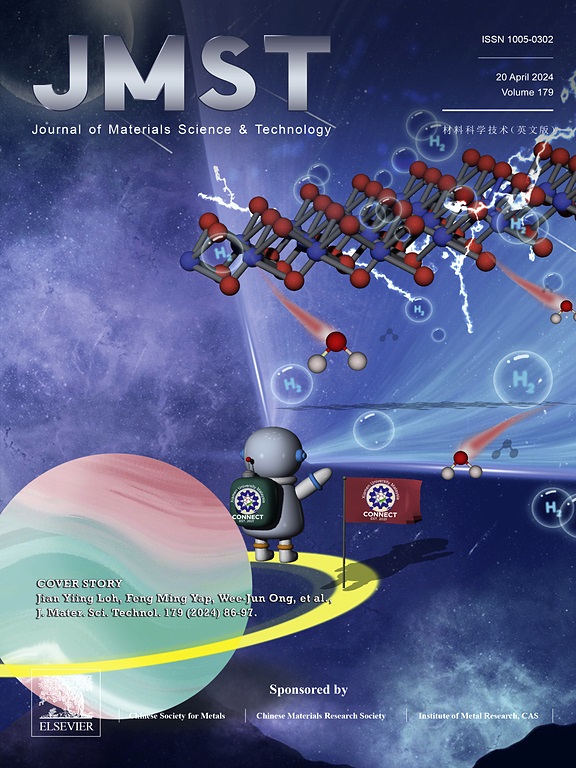Enhancing the mechanical properties and oxidation resistance of high-entropy (Ti0.2Zr0.2Hf0.2Nb0.2Ta0.2)C0.95 ceramics through nitrogen doping
IF 14.3
1区 材料科学
Q1 MATERIALS SCIENCE, MULTIDISCIPLINARY
引用次数: 0
Abstract
High-entropy carbide ceramics (HECCs) exhibit superior properties compared to their constituent binary compounds. However, high synthesis and sintering temperature are main obstacles that limit their widespread applications. To address this issue, compositional and particle size controllable high-entropy (Ti0.2Zr0.2Hf0.2Nb0.2Ta0.2)Cx powders were successfully prepared by a sugar hydrogel combined with the carbothermal reduction method. Owing to the introduction of carbon vacancy, the temperature for the formation of single-phase solid solution of the high-entropy (Ti0.2Zr0.2Hf0.2Nb0.2Ta0.2)Cx powders was decreased, and the addition of nitrogen decreased the densification temperature of the high-entropy (Ti0.2Zr0.2Hf0.2Nb0.2Ta0.2)C0.95 ceramic by 200°C. In addition, the flexural strength and fracture toughness of the high-entropy (Ti0.2Zr0.2Hf0.2Nb0.2Ta0.2)C0.95 ceramic were improved by 29% and 30%, respectively, compared with those without nitrogen doping. Atomic-resolution high angle annular dark field scanning transmission electron microscopy (HAADF-STEM) and energy dispersive spectroscopy (EDS) mapping reveal that the segregation of N and small cation Ti as well large lattice strains are responsible for the enhanced mechanical properties. Furthermore, with the introduction of nitrogen, the onset oxidation temperature (OOT) was increased, while the parabolic oxidation rate constant was decreased, revealing the beneficial effect of nitrogen doping on oxidation resistance. These results demonstrate that nitrogen doping can not only improve the mechanical properties of HECCs but also enhance the oxidation resistance, which paves the way for the wide application of HECCs.

氮掺杂提高高熵(Ti0.2Zr0.2Hf0.2Nb0.2Ta0.2)C0.95陶瓷的力学性能和抗氧化性
与二元化合物相比,高熵碳化物陶瓷(HECC)具有更优异的性能。然而,高合成温度和烧结温度是限制其广泛应用的主要障碍。为了解决这个问题,我们采用糖水凝胶结合碳热还原法成功制备了成分和粒度可控的高熵 (Ti0.2Zr0.2Hf0.2Nb0.2Ta0.2)Cx 粉末。由于引入了碳空位,高熵(Ti0.2Zr0.2Hf0.2Nb0.2Ta0.2)Cx粉末的单相固溶体形成温度降低,氮的加入使高熵(Ti0.2Zr0.2Hf0.2Nb0.2Ta0.2)C0.95陶瓷的致密化温度降低了200℃。此外,与未掺氮的陶瓷相比,高熵 (Ti0.2Zr0.2Hf0.2Nb0.2Ta0.2)C0.95 陶瓷的抗折强度和断裂韧性分别提高了 29% 和 30%。原子分辨率高角度环形暗场扫描透射电子显微镜(HAADF-STEM)和能量色散光谱(EDS)图显示,N 和小阳离子 Ti 的偏析以及较大的晶格应变是机械性能增强的原因。此外,随着氮的引入,起始氧化温度(OOT)升高,而抛物线氧化速率常数降低,揭示了氮掺杂对抗氧化性的有利影响。这些结果表明,掺氮不仅能改善 HECC 的机械性能,还能增强其抗氧化性,从而为 HECC 的广泛应用铺平了道路。
本文章由计算机程序翻译,如有差异,请以英文原文为准。
求助全文
约1分钟内获得全文
求助全文
来源期刊

Journal of Materials Science & Technology
工程技术-材料科学:综合
CiteScore
20.00
自引率
11.00%
发文量
995
审稿时长
13 days
期刊介绍:
Journal of Materials Science & Technology strives to promote global collaboration in the field of materials science and technology. It primarily publishes original research papers, invited review articles, letters, research notes, and summaries of scientific achievements. The journal covers a wide range of materials science and technology topics, including metallic materials, inorganic nonmetallic materials, and composite materials.
 求助内容:
求助内容: 应助结果提醒方式:
应助结果提醒方式:


